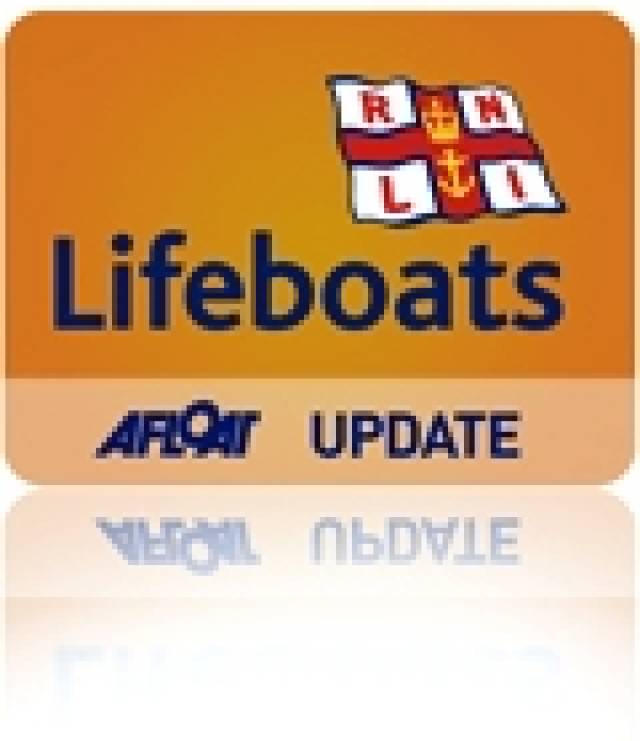Flags at RNLI lifeboat stations have been lowered today (Thursday 3 September) as a unique memorial, dedicated to those who lost their lives while helping to save others at sea, is unveiled outside the Lifeboat college in Dorset. Of the 778 people commemorated on the RNLI Memorial, 65 are from Irish lifeboat stations.
Relatives, friends and RNLI staff will attend the Ceremony of Dedication, being held in memory of those connected with the charity that made the ultimate sacrifice while saving lives at sea. The sculpture will be unveiled by HRH the Duke of Kent. The RNLI Divisional Inspector for Ireland Martyn Smith and Fundraising and Communications Manager Anna Classon will be attending the event.
At 12.20pm a one-minute silence will be held with RNLI lifeboat crews and supporters throughout Ireland and the UK also observing the silence. As an additional mark of respect, RNLI lifeboat stations and offices have been asked to fly the RNLI flag at half-mast.
Members of the public who wish to pay their respects may add a tribute to the RNLI online book of commemorate at www.rnli.ie/commemorate. A full list of the names inscribed on the memorial is also there.
In Dun Laoghaire on 24 December 1895, 15 lifeboat crew tragically lost their lives when the No. 2 lifeboat capsized on service to the steamship Palme. The No. 1 lifeboat also capsized but fortunately all the crew were able to get safely back to shore. A memorial overlooking the harbour to the 15 lifeboatmen can be seen close to the lifeboat moorings. The names of these men are inscribed on the memorial. Former Dun Laoghaire lifeboat volunteer Billy Scully will be attending the ceremony and will read out the list of Irish lifeboat stations that have lost people.
Commenting on the event Billy Scully says, “Every Christmas Eve in Dun Laoghaire we remember our lost lifeboat crew while at the same time acknowledging everyone who has been lost at sea over the years. It is fitting that the memorial has been erected outside the lifeboat college where RNLI crewmembers go to train and meet with other lifeboat volunteers across Ireland and the UK.”
Another name on the memorial is the last RNLI Irish crewmember to be lost while out on a rescue. In 1977 The Oakley class lifeboat Lady Murphy launched to a report of red flares off Bannon Bay on Christmas Eve. After a fruitless search the Kilmore Quay lifeboat turned for home in worsening conditions. A high breaking sea capsized the lifeboat and the acting coxswain was washed over board. After a search he was picked up. Continuing her journey home the lifeboat capsized again. Only three crew remained on board; when she righted, all except one man were brought back on board. Crew Member Finton Sinnott lost his life.
Fellow lifeboat volunteer Joe Maddock was on the lifeboat that night, “People are rightly proud of their lifeboat volunteers. That night we all went out with great hope that we would rescue a life and come home safe and well to our families. We remember Finton locally with the memorial in Kilmore Quay and a plaque at the lifeboat station but we are also pleased that he is being remembered on this sculpture with fellow lifeboat crew and rescuers that also sadly lost their lives. People who are connected with the sea know it can be dangerous. I think it helps their family to know that they will be remembered by future generations.”
Andrew Freemantle, Chief Executive of the RNLI concluded, "The RNLI Memorial is a tribute to the many hundreds of people who have given their lives selflessly to save others over the last two hundred years and it will ensure that the sacrifices made by our volunteers, and others, while saving lives at sea are never forgotten. Its location, in front of The Lifeboat College here in Poole, is truly fitting and will inspire generations of lifesavers."The memorial sculpture of a person in a boat saving another from the water is inscribed with the family motto of the RNLI’s founder, Sir William Hillary: ‘with courage, nothing is impossible’, and is located within a small garden which will be open to the public.
The RNLI Memorial, designed by Sam Holland ARBS, stands more than 4.5m in height and symbolises the history, and future, of the RNLI in its most basic and humanitarian form. The sculpture is positioned on a dark plinth on which flat bands of stainless steel weave. The bands provide both the effect of waves and a material onto which the names of the people who have lost their lives can be engraved – thus becoming an intrinsic part of the memorial.































































